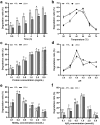Simultaneous degradation of two mycotoxins enabled by a fusion enzyme in food-grade recombinant Kluyveromyces lactis
- PMID: 38650290
- PMCID: PMC10991947
- DOI: 10.1186/s40643-021-00395-1
Simultaneous degradation of two mycotoxins enabled by a fusion enzyme in food-grade recombinant Kluyveromyces lactis
Abstract
Aflatoxin B1 (AFB1) and zearalenone (ZEN) are two predominant mycotoxins ubiquitously found in corn, peanuts, and other grains, which pose a great threat to human health. Therefore, safe and effective methods for detoxification of these mycotoxins are urgently needed. To achieve simultaneous degradation of multiple mycotoxins, a fusion enzyme ZPF1 was constructed by linking zearalenone hydrolase and manganese peroxidase with a linker peptide GGGGS. This fusion enzyme was secretory expressed successfully in the newly constructed food-grade recombinant strain Kluyveromyces lactis GG799(pKLAC1-ZPF1), and was investigated with the mycotoxins degradation efficiency in two reaction systems. Results showed that both AFB1 and ZEN can be degraded by ZPF1 in reaction system 1 (70.0 mmol/L malonic buffer with 1.0 mmol/L MnSO4, 0.1 mmol/L H2O2, 5.0 µg/mL AFB1 and ZEN, respectively) with the ratios of 46.46% and 38.76%, respectively. In reaction system 2 (50.0 mmol/L Tris-HCl, with 5.0 µg/mL AFB1 and ZEN, respectively), AFB1 cannot be degraded while ZEN can be degraded with the ratio of 35.38%. To improve the degradation efficiency of these mycotoxins, optimization of the induction and degradation conditions were fulfilled subsequently. The degradation ratios of AFB1 and ZEN by ZPF1 in reaction system 1 reached 64.11% ± 2.93% and 46.21% ± 3.17%, respectively. While in reaction system 2, ZEN was degraded by ZPF1 at a ratio of 41.45% ± 3.34%. The increases of degradation ratios for AFB1 and ZEN in reaction system 1 were 17.65% and 7.45%, respectively, while that for ZEN in reaction system 2 was 6.07%, compared with the unoptimized results.
Keywords: Kluyveromyces lactis; Aflatoxin B1; Degradation; Food-grade; Fusion enzyme; Mycotoxins; Zearalenone.
© 2021. The Author(s).
Conflict of interest statement
The authors declare that they have no competing interests.
Figures





References
-
- Armando MR, Pizzolitto RP, Dogi CA, Cristofolini A, Merkis C, Poloni V, Dalcero AM, Cavaglieri LR. Adsorption of ochratoxin A and zearalenone by potential probiotic Saccharomyces cerevisiae strains and its relation with cell wall thickness. J Appl Microbiol. 2012;113:256–264. doi: 10.1111/j.1365-2672.2012.05331.x. - DOI - PubMed
Grants and funding
LinkOut - more resources
Full Text Sources

